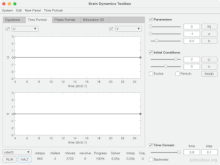
Back Oscil·lador de van der Pol Catalan Van-der-Pol-System German Oscilador de van der Pol Spanish نوسانساز ون در پل Persian Oscillateur de Van der Pol French Վան դեր Պոլի օսցիլյատոր Armenian Oscillatore di van der Pol Italian ファン・デル・ポール振動子 Japanese Van der Pol-vergelijking Dutch Oscylator van der Pola Polish
In the study of dynamical systems, the van der Pol oscillator (named for Dutch physicist Balthasar van der Pol) is a non-conservative, oscillating system with non-linear damping. It evolves in time according to the second-order differential equation where x is the position coordinate—which is a function of the time t—and μ is a scalar parameter indicating the nonlinearity and the strength of the damping.


- ^ Heitmann, S., Breakspear, M (2017–2022) Brain Dynamics Toolbox. bdtoolbox.org doi.org/10.5281/zenodo.5625923
© MMXXIII Rich X Search. We shall prevail. All rights reserved. Rich X Search
